I’m typically not a procrastinator, but yes, I was planning for the last 10 months to get to MIM (The Musical Instrument Museum) in Phoenix AZ to see my pal Lynn Wheelwright’s collection in their special exhibit The Electric Guitar: Inventing an American Icon.
When I realized that its last weekend was eminent, I had little choice but to book an overnight hotel, get new sorely-needed tires, gas up the car and just go.
It was well worth it, as it was a fresh look at MIM, which I haven’t been back to since our inaugural visit when they hosted AMIS in 2011.
Right off the bat, I was greeted by the “Stary Harp” (at left) – a Jamaican instrument/sculpture by “noted Rastafarian artist and priest” Evarald Brown. It struck me as kind of a “folk art” version of a Fred Carlson creation, combining guitar, harp, drum and kalimba (so about a tie with Fred’s “Taproot”).
The Electric Guitar exhibit had a waiting line throughout the day (I heard they were poised to possibly hit 60,000 paying visitors!), so I first wandered around a bit.

The introductory Guitars Courtyard had been updated with several nice new pieces, but I was amused to see that completely obscure German builder’s 1994 “Dyer knockoff” still on display.

Almost immediately, I spotted several signs stating “ex-Walter Erdmann Collection.” Mr. Erdmann was “the friend I never met” that I wrote about early this year.

It was nice (if sad) to see a lot of friends’ ex-pieces and collections now on display. For example, they have a new exhibit for (a tiny portion) of my late friend Garry Harrison’s important fretless zither collection.
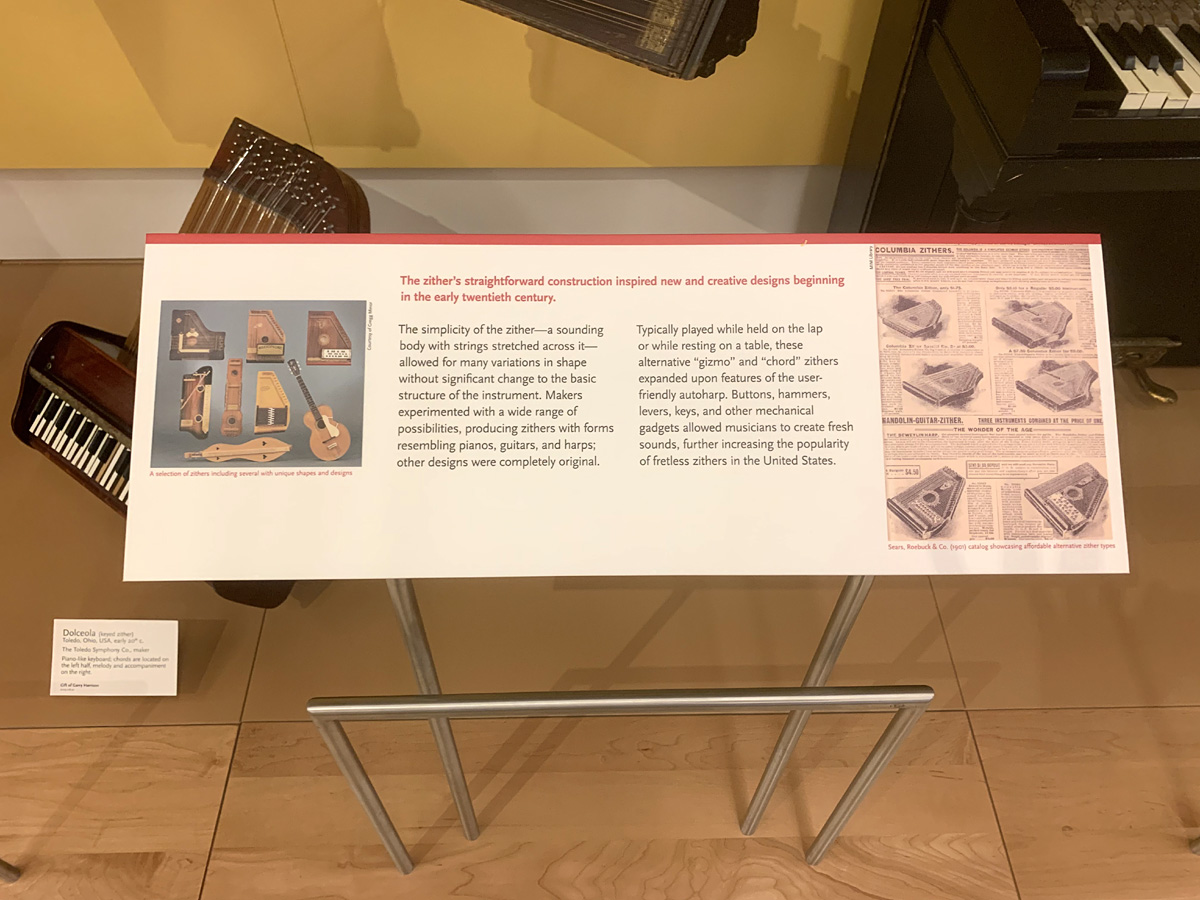
It was odd to see my A Christmas Collection booklet photo used for their signage. Obviously, that was for that specific musical recording I did – they need to strip the guitar out, and maybe the dulcimer…
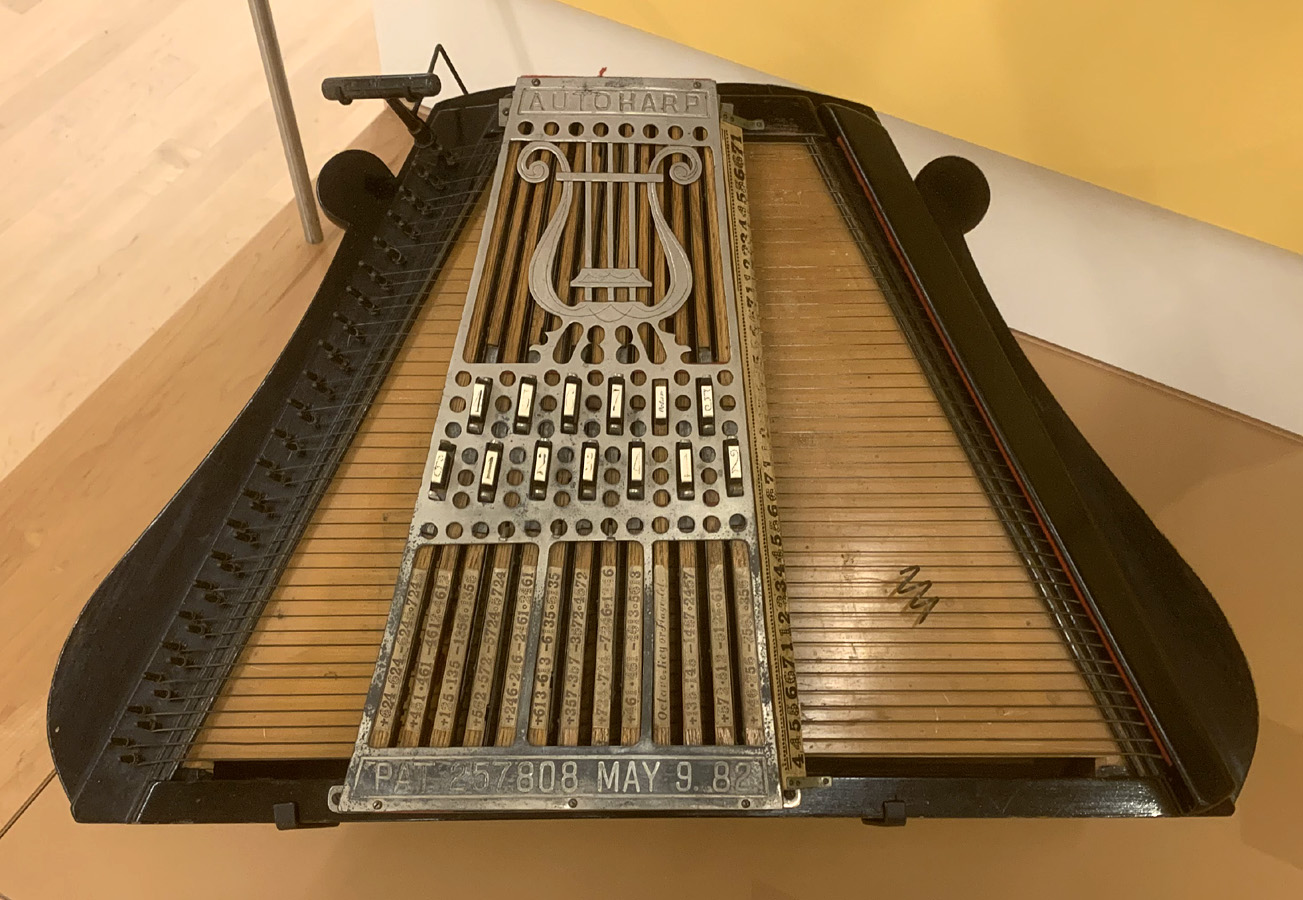
This was incredible (not from Garry’s collection) – I did not know the patent prototype Zimmerman Autoharp existed!
Nor the “harp piano-style Dolcette – a sort of giant keyboard fretless zither with Marxophone-like hammers-induced tremolo.

Another new one for me (on the right) – the H. F. Meyers mandobass.

They even have the beginnings of a harp guitar display. True, the key piece is the Scherr (the one from the Inventing the American Guitar book, ex-Szego collection). Here’s where I’d do my “What’s in a Name?” lecture, but that’ll come. They have a permanent loan of one of William Eaton’s creations and a Gibson, but in the basement ready to be added is Grisman’s Style 8 Dyer (the one with the “sidewalls” I wrote about in 2010).

The video includes Muriel Anderson, Will Eaton’s Electric Harp Guitar Group and Pat Metheny. The signage includes the Scherr (again, semi-out of context), Michael Hedges, Linda Manzer, Andy McKee and mentions builder Mike Doolin!

Elsewhere, Bart Applewhite’s beautiful harp bass resides in “Arizona Builders.”

There are of course vast galleries of instruments from every country on earth (MIM’s original charter and bread and butter). One can simply never take it all in, and you’ll always spot something you never noticed, if not brand new to the collection or displays. Here’s my favorite of this trip (again, easy to go unnoticed): a phet banam from India, it’s just a small rectangle for cryin’ out loud! But it has a cut out to fret the slab neck, and a shallow, lizard skin soundboard tone chamber.
The MIM enjoys lots of “museum partnering” of late, including with Graceland (they had not only Presley’s guitar, but his telegram wishing the Beatles good luck on the Ed Sullivan show (a sort of “hope it works out for you” motif…).

There were old and rare things from Spain’s Barcelona Music Museum sprinkled here and there.


And the Musical Box Society is contributing to the lovely Mechanical Musical Instruments room.

It was fascinating to watch a historical video about the “recording piano” company house musician creating music rolls, and seeing his actual recording piano and machinery right there.
At the new Woodstock exhibit (including Roger Daltrey’s outfit, too small for me as it turns out), I caught up with the curator I came to meet, Rich Walter. He was there on overtime for the whole weekend of their Rock ‘n Roll celebration, but found time amidst his many duties to take me into his Electric Guitar special exhibit and other halls.
And now, the exhibit:

As I said, it was packed for this last weekend. As I was last one out and almost first one in, I could get some decent photos, and also absorb the text and videos.
Introduction on the left, Lynn’s story on the right. I love Rich’s description of him as an “idiosyncratic expert.” That’s what I’ve always longed to become!

Alvino Rey (on wall) and several of his original instruments.

Yes, this is actually Charlie Christian’s guitar. It was also cool to see George Benson in the videos discussing and playing many of these iconic instruments.

Roy Smeck’s and other artist’s instruments.
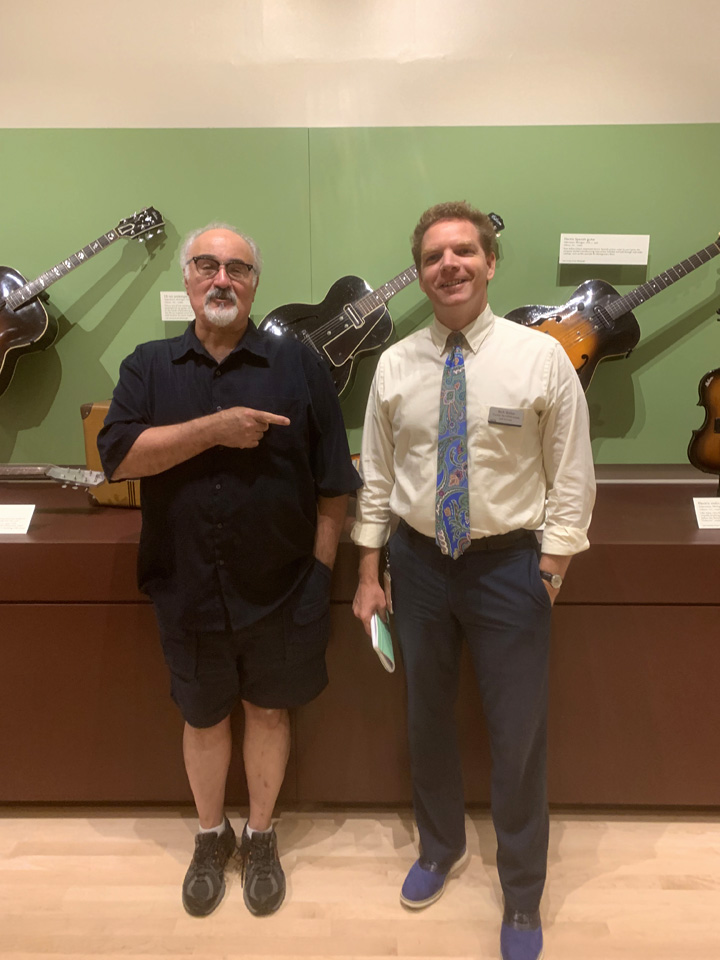
The man himself, Lynn Wheelwright, flew in to be around for the closing weekend. He’s pointing to curator Rich Walter, who he says did all the actual work (and I believe him).
I only had a short time with Lynn in the hall, and could have spent the entire weekend just hearing the stories of how his whole 3000-piece collection has happened. Lynn is to the “early electric guitar” what I am to harp guitars, multiplied by a hundred (now let’s just get him to write and publish as I have!). It was extremely exciting, impressive (if exhausting) to read sign after sign of “the first one,” “the earliest example,” “the only one known,” etc. Historically priceless from the design/engineering/invention standpoint, let alone the performers’ stories… Here, the public saw Lynn’s history-making treasures once owned by Charlie Christian, Roy Smeck, Speedy West and many more, including of course Alvino Rey, who the public learned kick-started this whole trajectory for Lynn, and ultimately, posterity. Though the bulk of the displays and info comes from Lynn Wheelwright, other contributions came from Deke Dickerson and several anonymous loans.
ANYONE who plays guitar and especially electric guitar would have enjoyed it, and if you missed it, you can still get the terrific and inexpensive catalog, of which the store still has copies.
Here are a few more photos of instruments not in the book, taken for my (and others’) reference. Hopefully, you can read the text.





I highly enjoyed meeting Rich and our brief time as we chatted about the museum’s past, present and future (successes and challenges). His heart (and energy) are definitely in the right place and I can’t thank him enough. Despite my impromptu last-minute visit, I was treated like royalty, and also want to mention that everywhere I went, the entire staff of numerous docents, volunteers and guest services desk were welcoming, interested, helpful and knowledgeable.
P.S. Go.
P.P.S. And on your way out, leave a note in the Comments Box for “Harp Guitar Exhibit”…




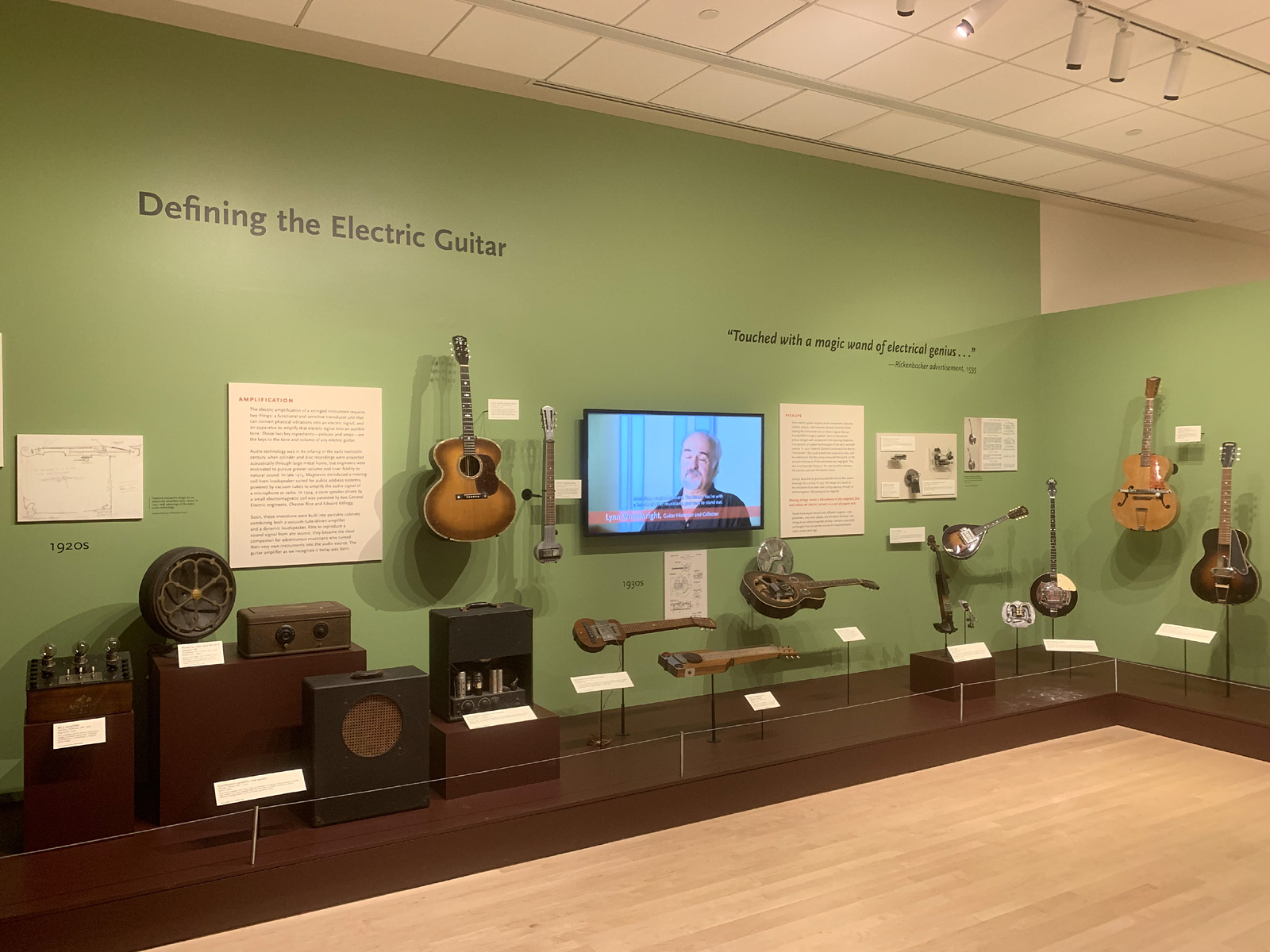


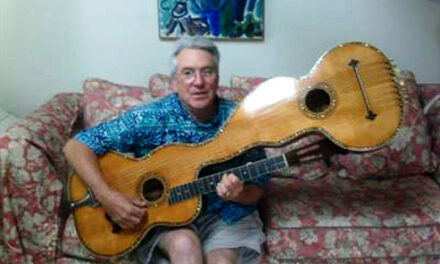


I HAVE ZIMMERMAN AUTOHARP PAT#257808 MAY 9,1882 MY COLLECTION MUSIC INSTRUMENTS SAME AS YOUR PHOTO –PURCHASED FROM ZIMMERMAN 1930’S PITTSBERG,PA.FOR DOW CHEMICALS MUSIC DEPT. MEN OF MUSIC -REGARDS BOB HUNT MIDLAND,MI.
Cool!